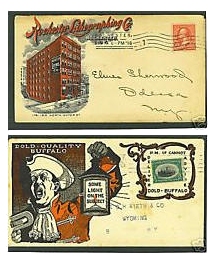Collecting Advertising
and Illustrated Covers
by Bill Weiss
INTRODUCTION
In 1845 an Act of Congress abolished postage rates based on the number of sheets used in forming a letter, thus began the widespread use of envelopes to send letters. Until that time envelopes were rarely used since they constituted an extra sheet of paper, thus a higher cost. Before long merchants began to use envelopes to advertise their products and services, and organizations used them to advocate for certain causes, such as cheaper postage rates, temperance, etc., or to promote a political candidate.
The first machine-made envelopes appeared in the United States in 1848 and in 1853 the first Government stamped envelopes were issued, and by the mid-1850s envelopes were no longer a novelty and the use of them for advertising purposes was becoming increasingly popular. During the Civil War, another type of illustrated envelope - the Patriotic cover - became very popular and widely used, but they constitute a major collecting category of their own (see our guide on them elsewhere). By the end of the Civil War the use of advertising covers was commonplace and probably thousands of different designs exist produced before 1865,Audemars Piguet Replica Watches and tens of thousands after, through 1900, and tens of thousands after 1900.

PRINTING METHODS
Several different types of printing methods were (and are) used to produce illustrated designs on paper, and while it is not the intent of this article to discuss in depth this aspect, it is interesting to note them. WOODCUT or so-called CAMEO designs are those where the design is engraved in reverse, then ink is applied to the flat or raised portion and the result that is illustrated is the portions which are uninked. These designs are sometimes embossed and sometimes not, but all of those of this style are called "cameos" based on their resemblance to the ornamental jewelry of the same name. These designs were most prevalent in the 1850s and 1860s and many impressive designs exist. ENGRAVED designs were probably the most expensive to produce and by definition are the opposite of the woodcut, with ink being added to the etched portions of the design and the illustration being the inked portion. LITHOGRAPHY was the cheapest and most widely used process for printing on envelopes. Offset printing is a more advanced method of lithographic printing. In this method the design is drawn in greasy ink on a stone, which is then wetted with an ink-repellent fluid which confines the ink to the greasy areas. A litho print resembles an engraved one, but without the "raised" effect found on engraving. Also, engraved lines are "finer" in appearance, whereas litho designs are "rougher" to the eye.

COLLECTING ILLUSTRATED COVERS
Advertising covers were once described by a well-known dealer (Al Pundt) as "miniature works of art", and so they are. Until recent years, they were often not considered to be "serious" postal history by many, but have now come into their own with the development of a Display Class of philatelic exhibiting. Collecting ad covers, like any other type of collecting, is based on personal preference. Some collect ALL ad covers while others collect by topic, by locality (State, county, city, etc), by period or by style. In 1982 the collection formed by John Biddle was sold at public auction and that catalog - the AMERICAN ILLUSTRATED COVER CATALOG was the first to arrange and illustrate, in color, all of the covers in the sale. It remains to this day a valuable and interesting book and is available from philatelic literature dealers for around $50. for a hardbound copy.
PRICES
As with any collecting subject, prices vary from under $1.00 to many thousands of dollars. Really good advertising covers rarely appear in a venue such as eBay, and collectors need to subscribe to established philatelic auction catalogs, attend a bourse or seek out retail dealers who handle advertising covers. Each collector must set his own parameters in terms of prices he is willing to pay, but suffice it to say that no great collection of anything is ever formed without spending time and money on it unless the collectible has little or no resale or secondary market. Dealers are the backbone of any collectible and without them no secondary market exists and collectors should strongly consider supporting dealers and auction firms that handle the things they collect, as well as online venues such as eBay.





